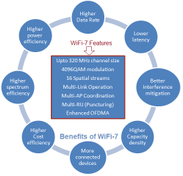Carrier Frequency Offset and Timing Drift in WiFi-7
Explore how carrier frequency offset (CFO) error and timing drift impact synchronization in Wi-Fi 7 (IEEE 802.11be), affecting signal demodulation and overall network performance.
Showing 10 posts (Page 1 of 1)
Advertisement
Explore how carrier frequency offset (CFO) error and timing drift impact synchronization in Wi-Fi 7 (IEEE 802.11be), affecting signal demodulation and overall network performance.
Minimum input sensitivity is the lowest power level a receiver needs to decode a signal successfully in Wi-Fi 7. It impacts range, performance in noisy environments, and power efficiency.

An overview of spectral flatness in Wi-Fi 7, focusing on its importance in ensuring uniform power distribution across the channel bandwidth and maintaining signal integrity.
Transmit power accuracy and RSSI measurement are critical in WiFi 7 for reliable wireless communication, performance optimization, and interference management.

Explore the WiFi 7 Extremely High Throughput (EHT) frame structure based on IEEE 802.11be, including preamble, EHT-SIG fields, and data field enhancements.

Explore Wi-Fi 7's transmit spectral mask, critical for minimizing interference and ensuring efficient spectrum use with wider channels and higher-order modulation.

Explore WiFi 7 architecture, including PHY/MAC layer enhancements, MLO, and benefits like higher data rates, reduced latency, and improved spectrum efficiency.

Explore WiFi 7 Multi-Link Operation (MLO) for increased data rates, lower latency, and improved reliability. Learn about MLO modes, architecture, and benefits as per the IEEE 802.11be standard.

Explore the critical role of transmitter modulation accuracy, particularly Error Vector Magnitude (EVM), in ensuring reliable and high-speed data transmission in WiFi 7.

Explore WiFi 7 (IEEE 802.11be), its key features like 320 MHz channels, 4096 QAM, MU-MIMO, and Multi-Link Operation, and the benefits it offers over previous WiFi generations.
Advertisement